One of the most popular schooling fish kept in aquariums is Danios, a genus of around 27 different species. New species are continually added to the Danio genus, although they aren’t necessarily available as pets. Only a handful of danios are appropriate for aquariums, with some more popular than others.
This article will cover the main species of danios and their care, breeding habits, and benefits in aquariums.

Species Profile: About Danios
Danios are freshwater fish that originate from Southern Asia, where they swim in streams, swamps, and rice fields. They live throughout Thailand, Myanmar, Bangladesh, and Nepal. Danios were first described in 1822 by Francis Hamilton, starting with two species – the D. rerio and the D. dangila.
More species were in the genus up until the early 1900s before the genus divided. The smaller species were placed in the Danio genus, while the larger species were placed in the Brachydanio genus. Around 30 years ago, the two genera were reclassified into the Danio genus. However, some of the larger species, like the giant danio, are in the Devario genus.
Most species of Danio are highly social and active. They are also hardy enough to be kept by beginner fish keepers. Their size is dependent on their species, but most grow between 1.5 to 6 inches long as adults. Danios have an average lifespan of three to seven years and can live for over five years with proper care.
Basic Care Requirements
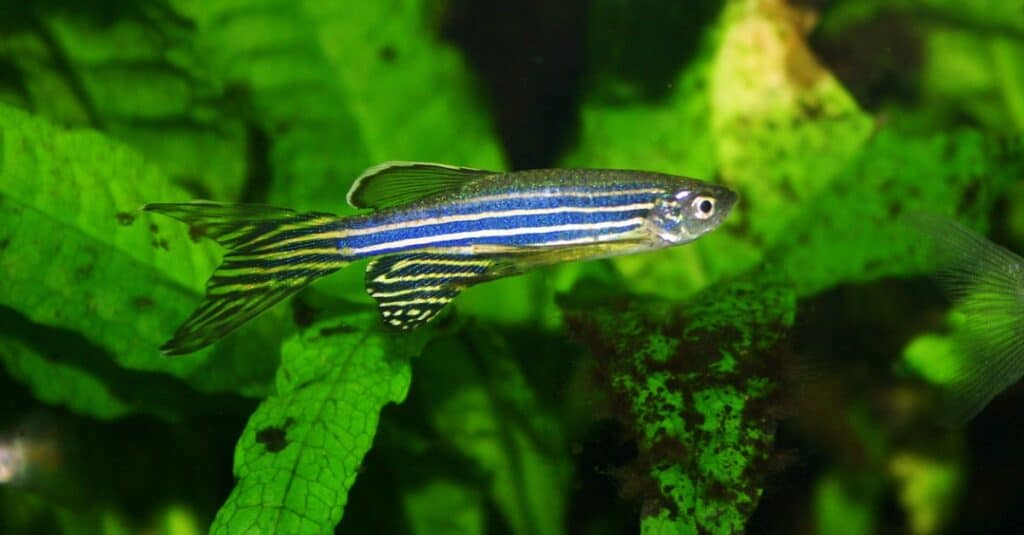
The zebra danio’s stripes make it stand out despite its small size. Mainly because of their vibrant colors.
©iStock.com/MATTHIASRABBIONE
If you are considering danios for your aquarium, below is a summary of what their care entails.
- A spacious freshwater fish tank with more horizontal swimming space. Danios should never be housed in bowls or other small aquaria-like vases.
- A good filtration and aeration system should run 24/7 in a danios aquarium.
- Danios are social fish that should be kept in groups of six or more of the same species. They should never be alone or in pairs. They feel more secure in numbers and may show signs of stress when kept alone.
- Live plants are beneficial for danios but are not a necessity.
- You ideally want to keep their water heated to around 65 to 80 degrees Fahrenheit (18 to 26 degrees Celsius).
- The minimum tank size for most danios is 16 gallons. However, most of the larger species require tanks over 20 gallons in size.
- Danios require a well-maintained aquarium that has been cycled. They rely on having good water quality for their overall health and longevity.
- All danios are omnivores and need to be fed a varied diet consisting of plant and animal-based ingredients. Use a quality pellet, flake, or granule food specifically for danios. You can feed additional dietary supplements, like live bloodworms and baby brine shrimp, up to three times a week.
Danios in Scientific Research
Aside from being fantastic aquarium pets, danios also have a role in science and human research.
The D. rerio species has been used in scientific research since the 1960s for human genetics and disease. They have been chosen by researchers for their robust nature, rapid growth rate, ability to regenerate heart muscles, and similar genetic structure to humans. Furthermore, danios have high-quality genes that allow scientists to create thousands of mutations for additional research. Scientists use danios for various model studies like development and to study certain human diseases.
Different Species of Danios
Let’s discuss some of the main species of Danio and how you can care for them in your aquarium.
1. Zebra Danio (Danio rerio)
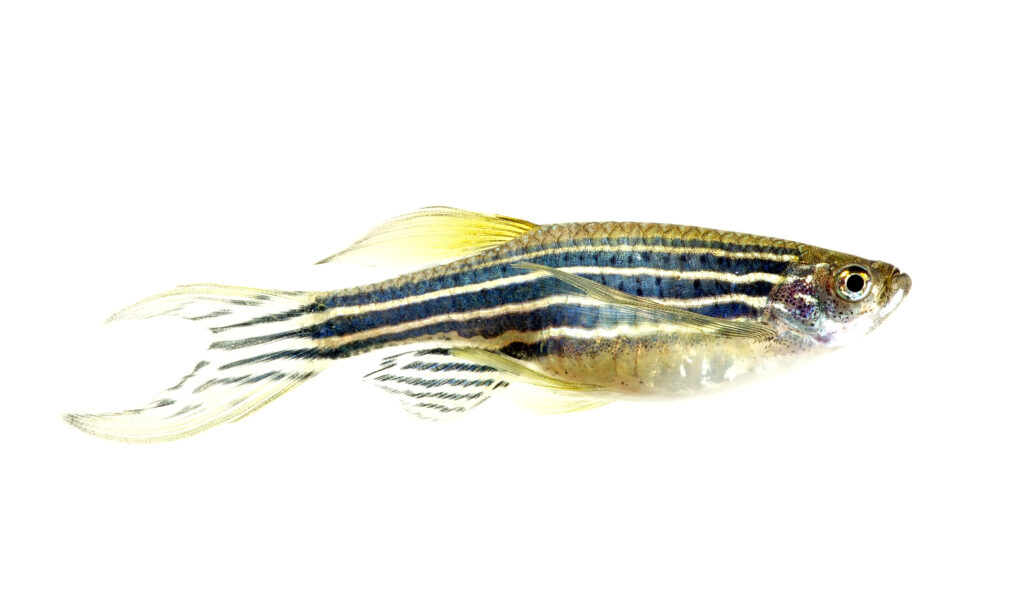
Zebra danios are kept in aquariums and used for scientific research.
©Grigorev Mikhail/Shutterstock.com
| Adult size: | 2 – 2.5 inches |
| Lifespan: | 3 – 7 years |
| Minimum tank size: | 16 gallons |
| Water temperature: | 65° – 80° Fahrenheit |
The most popular species of danio in the aquarium trade industry and for scientific research is the D. rerio, or simply the zebra danio.
They also fall under the common name zebrafish, which was given to them for their striped bodies. Zebra danios grow to around 2.5 inches long and are characterized by their torpedo-shaped bodies and horizontal stripes. They can be found in an assortment of colors, including pink, blue, green, purple, and red stripes. Zebra danios can either have short or long fins, but short fins are more common.
The zebra danios’ popularity in aquariums is fuelled by their peaceful and social temperaments. Zebra danios are not aggressive fish and form schools in the wild where they display fascinating social behaviors. They need to be kept in groups of six or more in aquariums to prevent them from becoming stressed.
2. Fireline Danio (Devario sondhii)
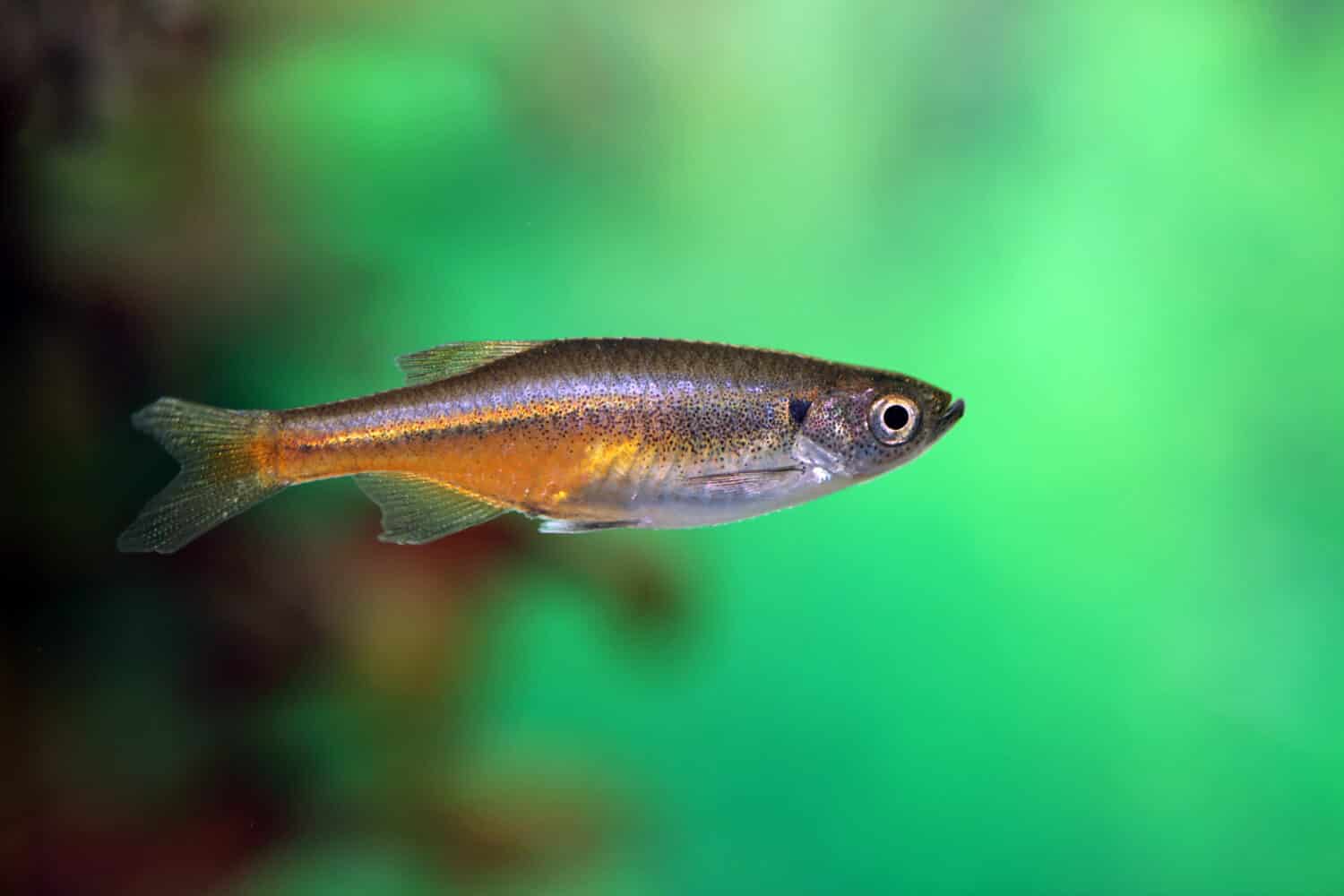
Interestingly, fireline danios are a new addition to the aquarium trade industry.
©boban_nz/Shutterstock.com
| Adult size: | 2 – 2.5 inches |
| Lifespan: | 3 – 7 years |
| Minimum tank size: | 16 gallons |
| Water temperature: | 68° – 78° Fahrenheit |
The newest species of danio added to the aquarium hobby is the fireline danio which has been around since 2007. Fireline danios originate from the shallow waters of the Southern Shan State and the Salween River Basin in Southeast Asia. Their natural habitat is very shallow and clear, often around 12 inches deep.
They are recognized by their vibrant red and orange bodies that are similar in shape to the zebra danio. Fireline danios grow to around 2.5 inches long and have short fins and slim bodies. They are very active and hardy fish that need to be kept in groups of six or more. Fireline danios enjoy hiding in dense vegetation in the wild, so they do benefit from having live plants in their aquarium.
3. Gold Ring Danio (Danio tinwini)
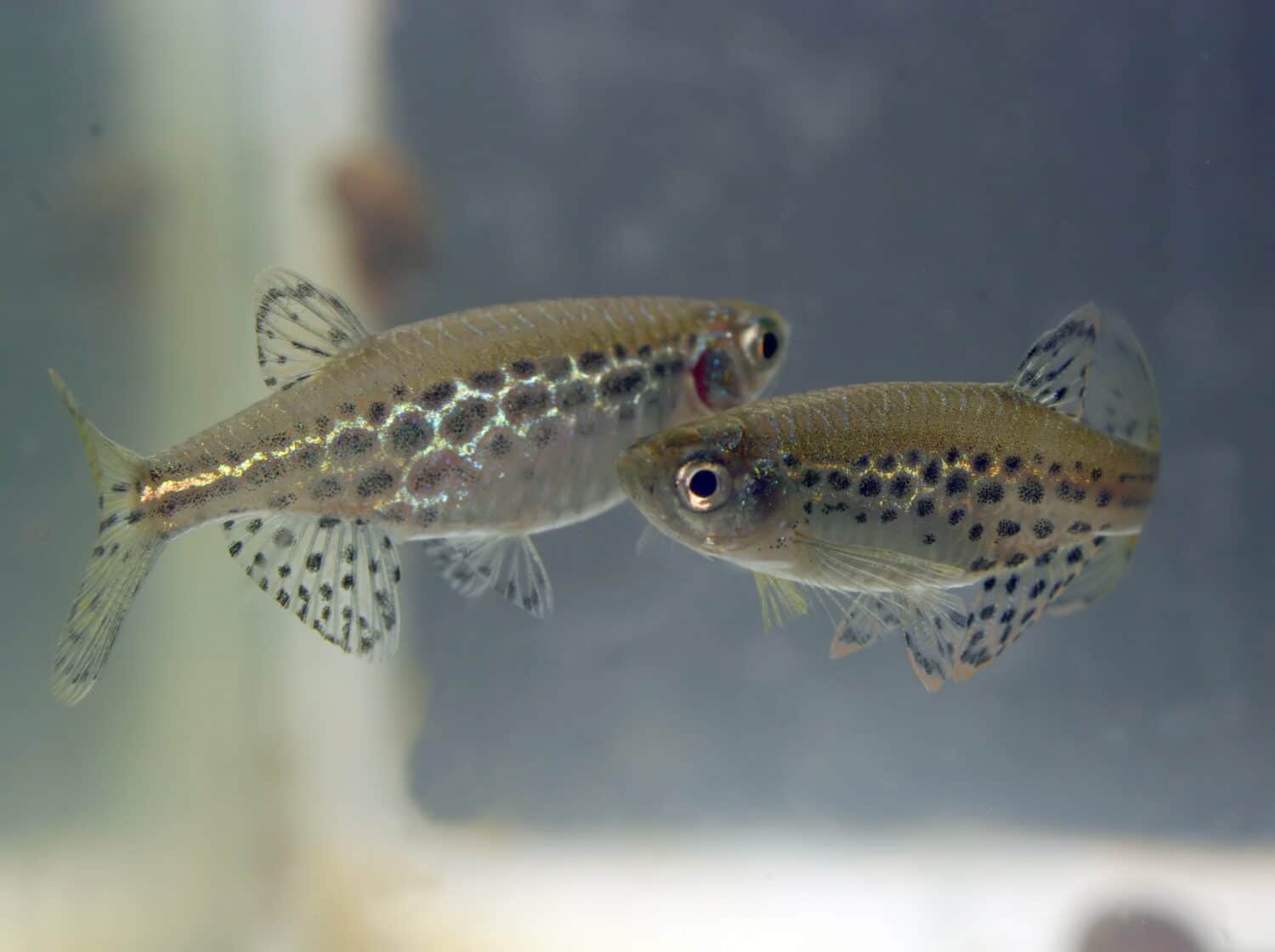
Gold ring danios have been kept in aquariums for only 20 years, although they only became widely available in 2005.
©VladiMil/Shutterstock.com
| Adult size: | 1 – 1.5 inches |
| Lifespan: | 3 – 7 years |
| Minimum tank size: | 12 gallons |
| Water temperature: | 65° – 80° Fahrenheit |
The gold ring danio has been in the aquarium trade industry since 2003, but it took a few years for them to become more widely available. Gold ring danios have an interesting appearance that makes them stand out against the above species. They have lines of small spots that look like leopard prints, and a blueish silver coloration. These spots can be seen along their dorsal and caudal (tail) fins rather than just their bodies. They are very small danios which only grow to around 1 to 1.5 inches long. Male gold ring danios have larger and more prominent fins, with females having slightly faded spots.
4. Blue Danio (Danio kerri)
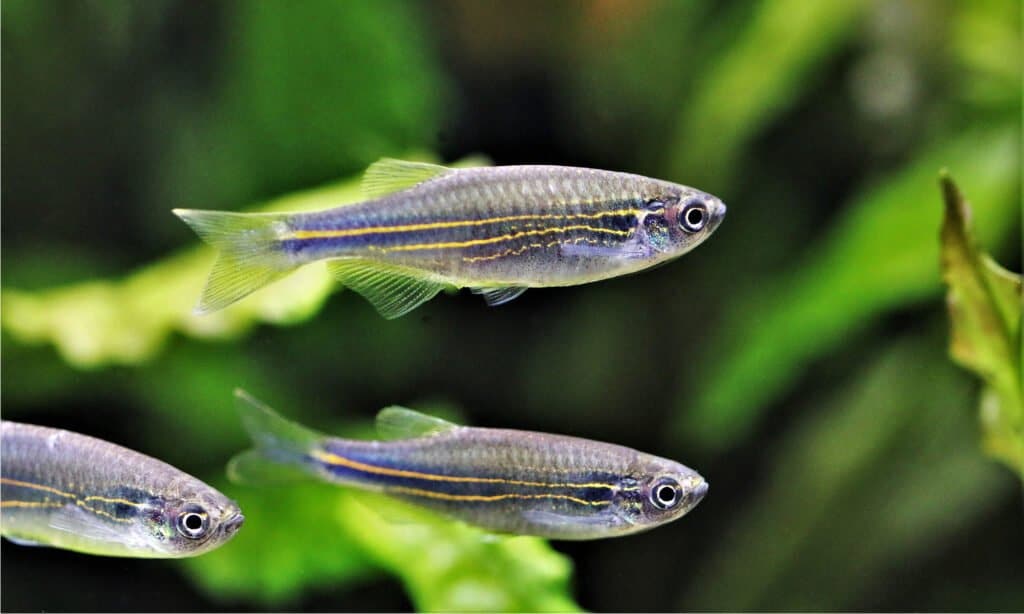
Blue danios are one of the 27 different species of danios, despite sometimes being confused for blue zebra danios.
©Arunee Rodloy/Shutterstock.com
| Adult size: | 2 inches |
| Lifespan: | 3 – 7 years |
| Minimum tank size: | 16 gallons |
| Water temperature: | 65° – 80° Fahrenheit |
Other than the zebra danio, the blue danio is a popular species for aquariums. Blue danios originate from fast-moving freshwaters that are well-oxygenated. They require a good filtration system in their aquarium, along with a spray bar or bubbler system for additional surface agitation.
As their name suggests, the blue danio features blue bodies with a slight yellow hue. They generally grow to around 2 inches long, which makes them compatible with nano aquariums. Keep blue danios in a group of six or more, though eight is usually ideal. They are very social fish and do not do well in small groups. Keeping blue danios together helps them feel safer and display their natural schooling behaviors like they do in the wild.
5. Rose Danio (Danio roseaus)
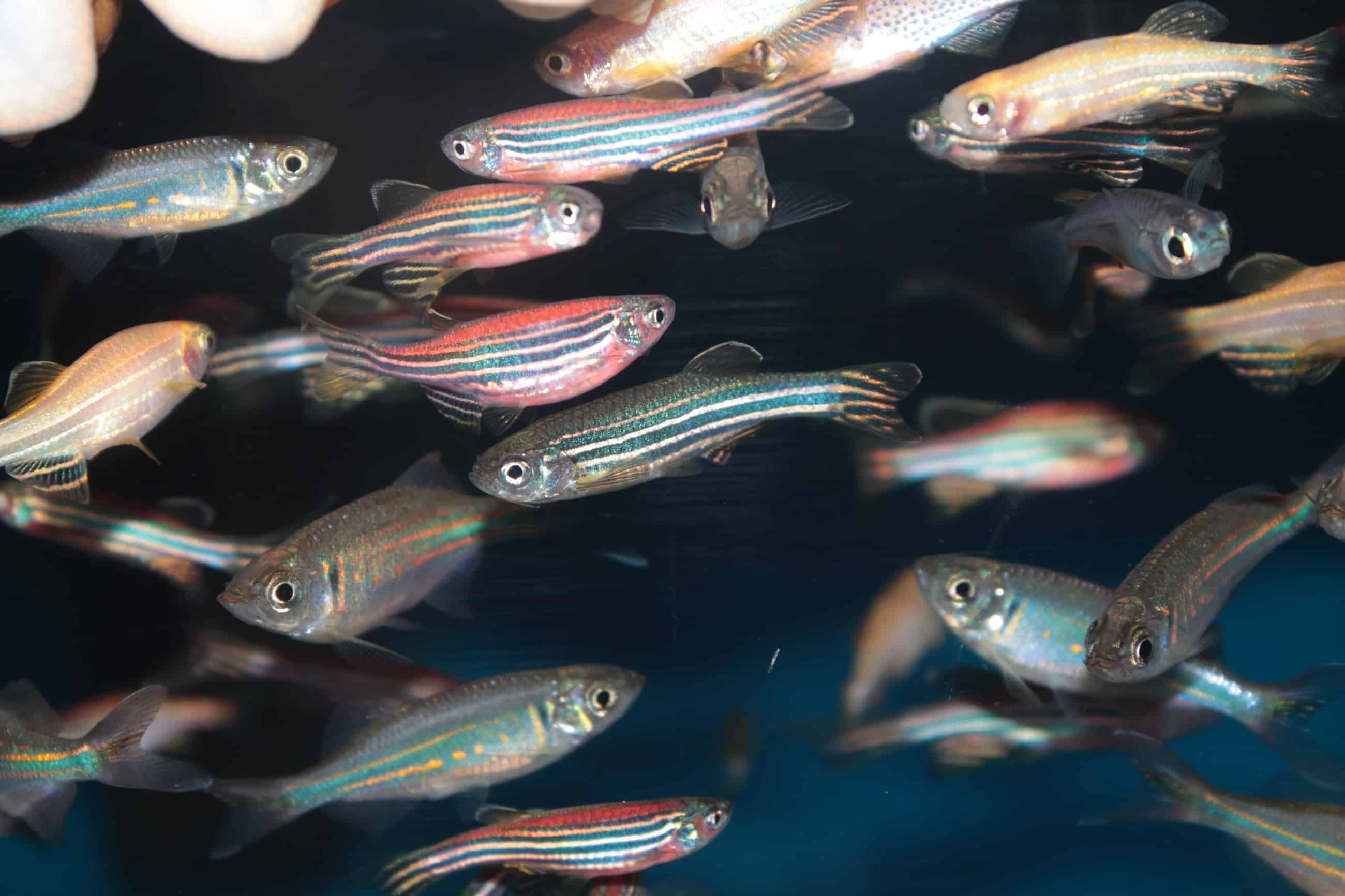
Danios are schooling fish and therefore need to be kept in groups of six or more.
©Kazakov Maksim/Shutterstock.com
| Adult size: | 1 – 1.5 inches |
| Lifespan: | 3 – 5 years |
| Minimum tank size: | 16 gallons |
| Water temperature: | 70° – 82° Fahrenheit |
The rose danio might not be as fascinatingly colored as the other species, but they still make good aquarium pets. Rose danios have a striped muted rose coloration that has earned them the nickname purple passion danios. They are a small species that grows to around 1.5 inches long, so tank size is not much of a concern. Any tank over 16 gallons in size is spacious enough to support a group of six or more rose danios.
Rose danio care is not much different than the other species, and they are suitable for beginner fish keepers. However, they do prefer a slightly warmer water temperature between 70 to 82 degrees Fahrenheit.
6. Glowlight Danio (Danio choprae)
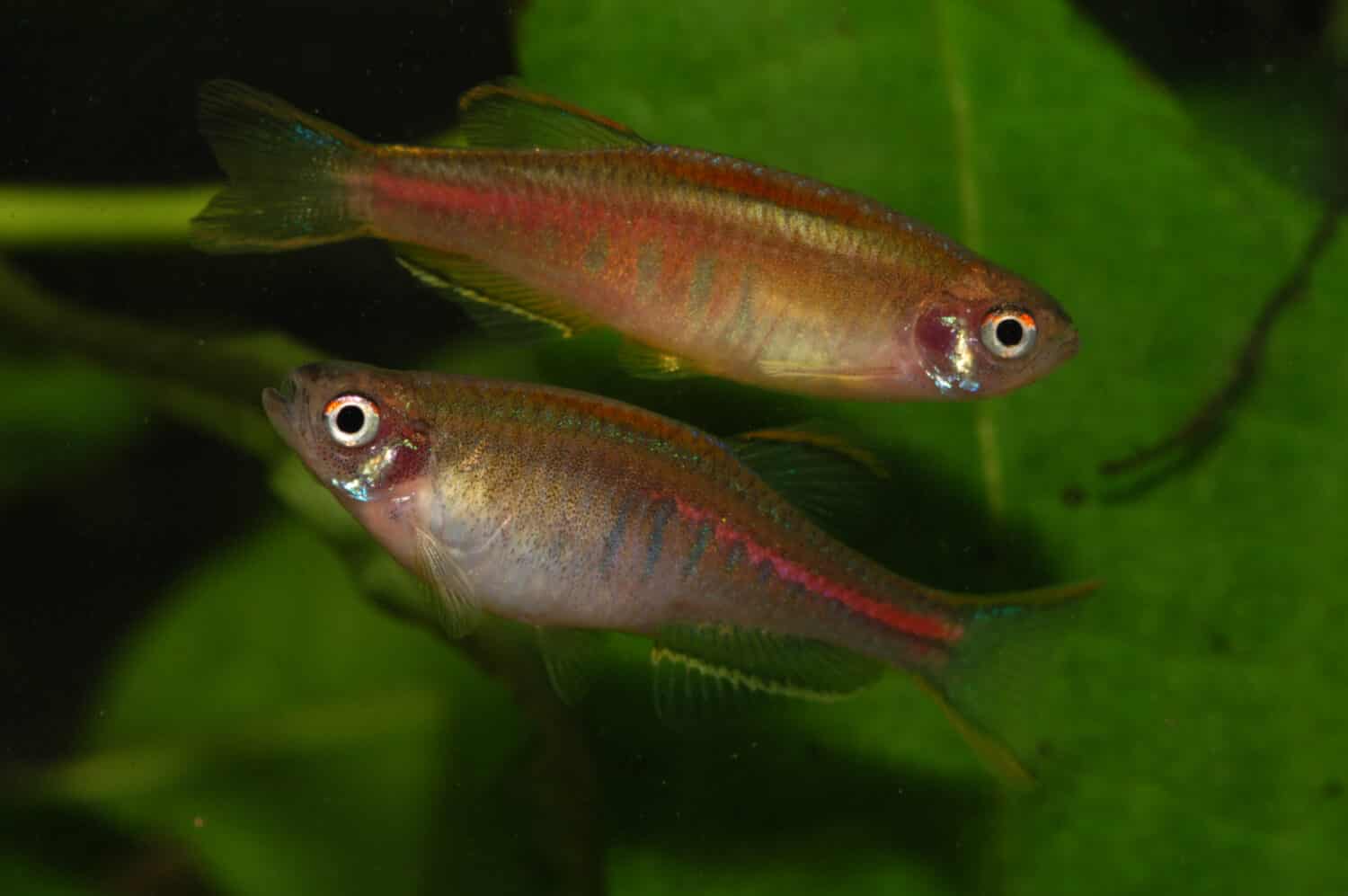
Glowlight danios should not be confused with Glo danios, besides, they are different species.
©Karel Zahradka/Shutterstock.com
| Adult size: | 1 – 1.5 inches |
| Lifespan: | 3 – 5 years |
| Minimum tank size: | 20 gallons |
| Water temperature: | 65° – 82° Fahrenheit |
One of the most colorful species of danio is the D. choprae or the glowlight danio. They are sometimes confused for genetically modified fish, although their coloration is completely natural. Glowlight danios stand out amongst the other species with their vibrant yellow and orange coloration. They have a combination of lines and faded bands which give off an iridescent hue of blue or pink.
Glowlight danios are highly active and social fish and need a group of six or more. Although they are relatively small at only 1.5 inches long, they require a spacious tank above 20 gallons. This is primarily because they are active and enjoy exploring their environment. Glowlight tetras thrive in planted aquariums and may become stressed without the safety of plants and aquarium decoration.
7. Celestial Pearl Danio (Danio margaritatus)
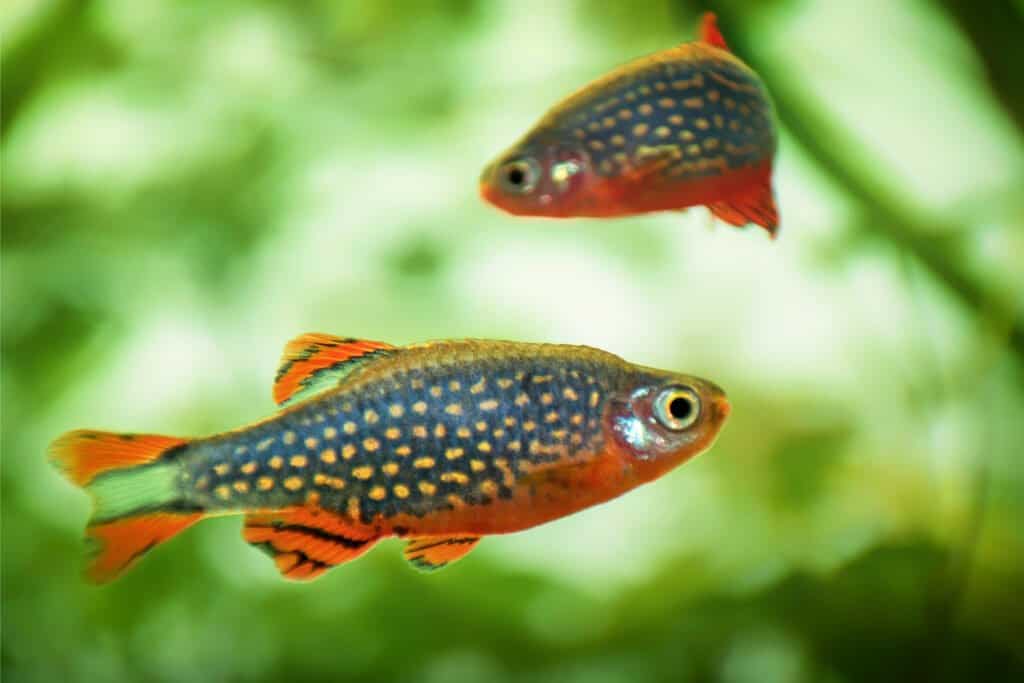
Danios are vibrantly colored fish, therefore they make popular aquarium pets.
©Magdalena Teterdynko/Shutterstock.com
| Adult size: | 1 – 1.5 inches |
| Lifespan: | 3 – 5 years |
| Minimum tank size: | 16 gallons |
| Water temperature: | 70° – 80° Fahrenheit |
Another popular species is the celestial pearl danio or galaxy rasbora, which has a striking appearance. Celestial pearl danios have vivid red fins and blue bodies adorned with small spots. They are nano fish at only 1.5 inches long but appreciate a large aquarium that they can explore and form large groups.
Their galaxy appearance isn’t the only popular aspect of the celestial pearl danio. They are incredibly peaceful fish that are easy to care for. Their care is suitable for beginner fish keepers who can keep them in a heated aquarium with live plants, a filter, and an aeration system.
Celestial pearl danios can be sensitive to changes in their water chemistry. They should only be in mature aquariums with zero traces of ammonia or nitrites. They can tolerate nitrates in the water up until 15 ppm before showing signs of toxicity.
8. Black-Barred Danio (Danio absconditus)

Instead of stripes, danios may have bars such as this barred danio pictured.
©Karel Zahradka/Shutterstock.com
| Adult size: | 2 – 2.5 inches |
| Lifespan: | 3 – 7 years |
| Minimum tank size: | 25 gallons |
| Water temperature: | 65° – 80° Fahrenheit |
One of the less commonly owned species is the D. absconditus or black-barred danio. They are named after their pale-yellow bodies and faint black bars or vertical stripes. The black barred danio originates from a tropical monsoon region near the Rakhine mountains in western Myanmar. There they inhabit streams with dense vegetation and a period of heavy rains for most part of the year.
If you choose to keep black-barred danios in your aquarium, don’t skimp on the live plants and driftwood. Black-barred danios do not enjoy sparsely decorated aquariums and rely on live plants to feel secure. Furthermore, live plants help create a natural environment for them which is similar to what they experience in the wild.
9. Giant Danio (Devario aequipinnatus)
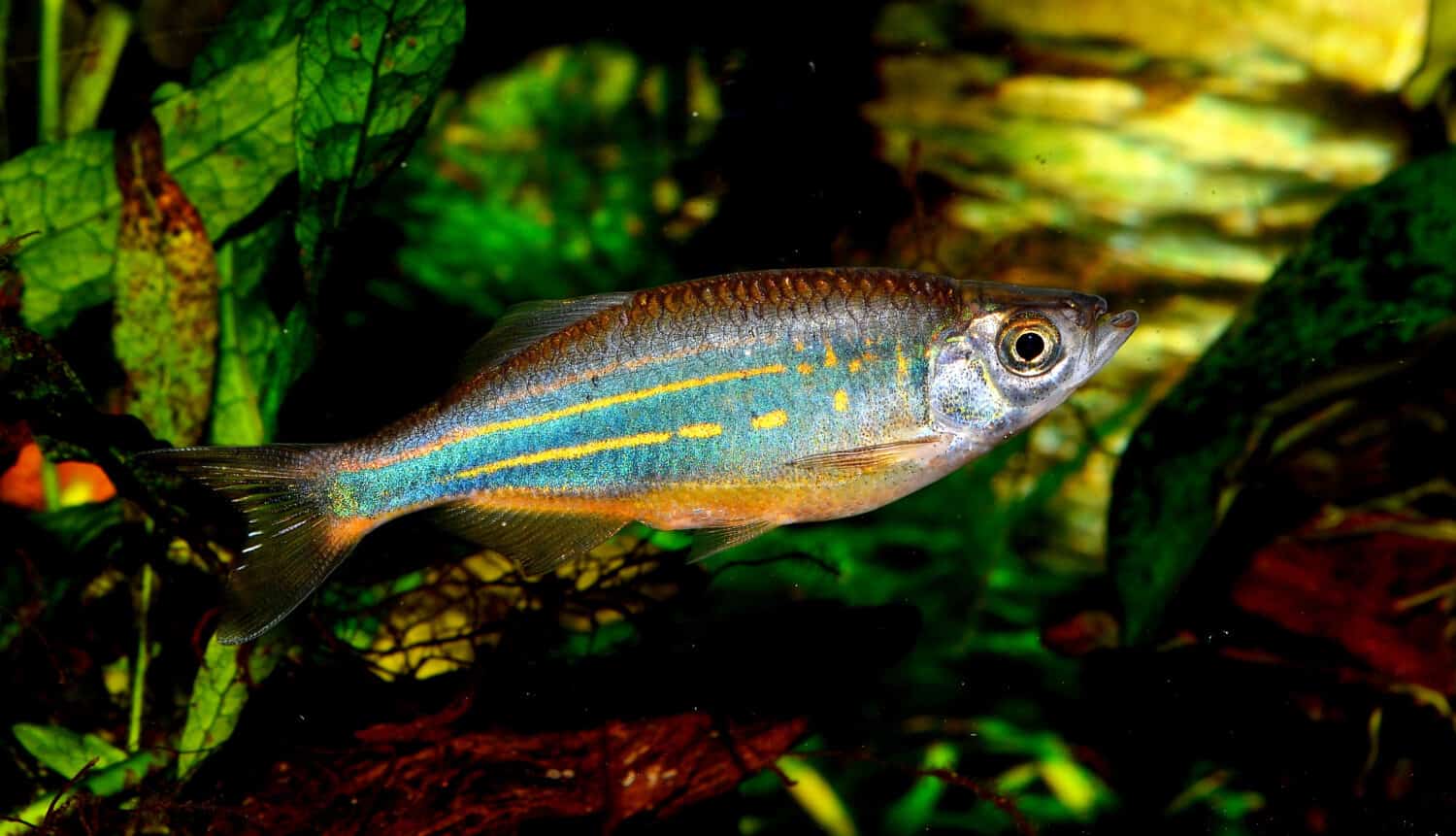
The giant danio can grow up to 6 inches long, therefore making them significantly larger than the other species.
©JuanCarlosPalauDiaz/Shutterstock.com
| Adult size: | 4 – 6 inches |
| Lifespan: | 3 – 7 years |
| Minimum tank size: | 40 to 55 gallons |
| Water temperature: | 72° – 80° Fahrenheit |
One of the largest species is the giant danio, scientifically known as the D. aequipinnatus. Adult giant danios can reach a length of 6 inches and take up a lot of space in aquariums. They are better suited for more experienced fish keepers who can keep them in large tanks over 55 gallons long. However, it is possible to keep them in a 40-gallon tank as juveniles and upgrade them to a larger tank over time.
Despite their size, giant danios form schools and need a group of six or more. Their large size and schooling are responsible for their more demanding tank size requirements. Giant danios have yellow and blue striped bodies and silver fins. They need tropical aquariums and thrive at a temperature range between 72 to 80 degrees Fahrenheit.
10. Moustached Danio (Danio dangila)
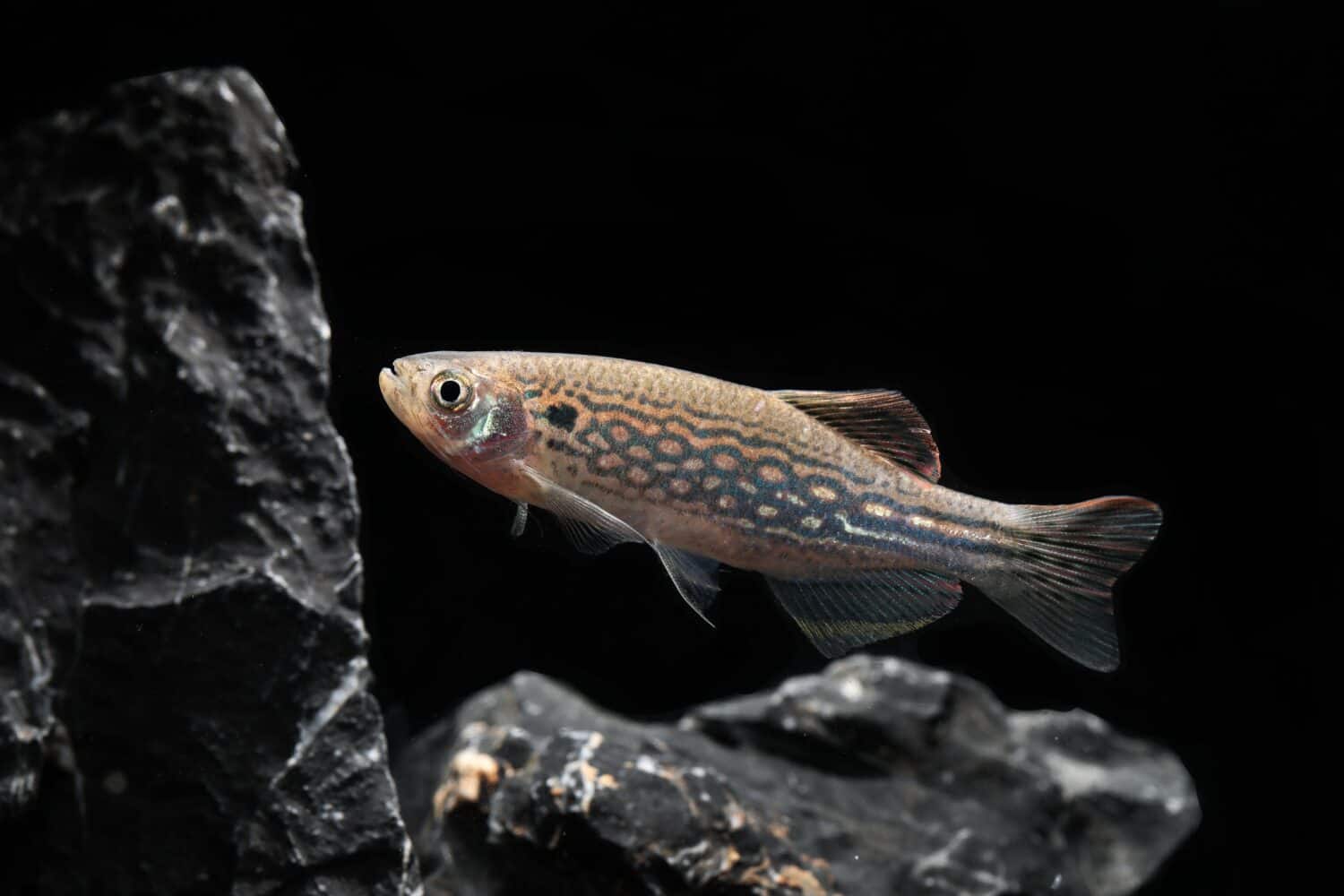
Moustached danios are the largest true species of danio which can grow up to 6 inches long.
©Pavaphon Supanantananont/Shutterstock.com
| Adult size: | 4 – 6 inches |
| Lifespan: | 3 – 7 years |
| Minimum tank size: | 55 gallons |
| Water temperature: | 70° – 80° Fahrenheit |
The moustached danio is the largest true species in the Danio genus, growing up to 6 inches long. Moustached danios get their name from their thin barbels that look like whiskers or a mustache. The rest of their body is a dull yellowish-orange coloration with faint lines and swirls.
Moustache danios are not as popular in aquariums as the other species, but they are still aquarium-friendly. Their large size makes them a good addition to tanks over 55 gallons, and you will need to keep them in groups of six or more. Moustached danios are social and peaceful and thrive in large community aquariums with other peaceful freshwater fish.
11. Dwarf Spotted Danio (Danio nigrofasciatus)
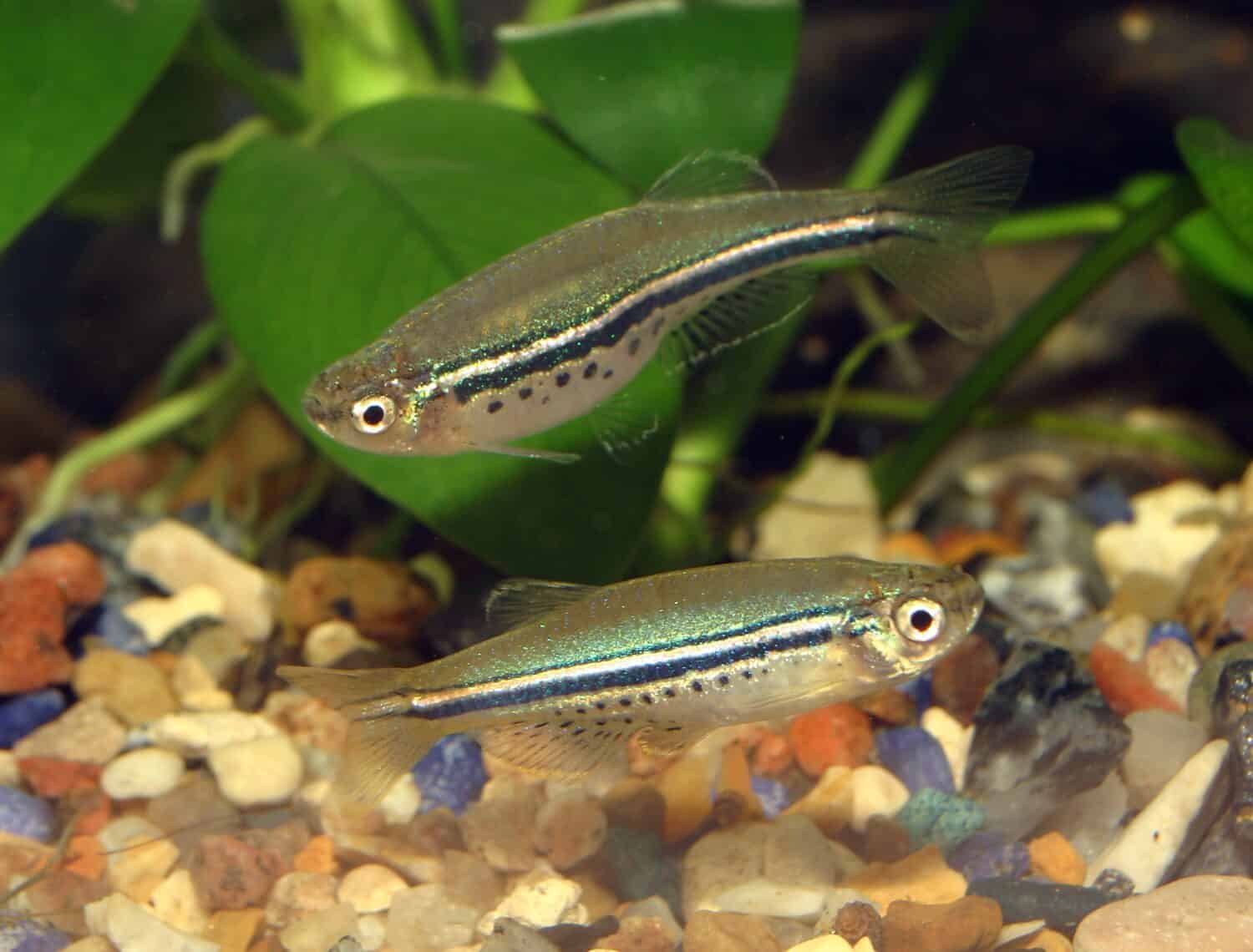
Dwarf spotted danios are recognized by their horizontal stripes with small dots underneath. Furthermore, their bodies have a greenish-blue iridescence.
©VladiMil/Shutterstock.com
| Adult size: | 2 – 2.5 inches |
| Lifespan: | 3 – 5 years |
| Minimum tank size: | 20 gallons |
| Water temperature: | 72° – 80° Fahrenheit |
The dwarf spotted danio has a vibrant blue and white stripe followed by tiny leopard spots below. They are endemic to Myanmar, specifically from the Ayeyarwady River drainage or the Bago Rivers. Dwarf-spotted danios grow to around 2 inches long as adults and require groups of six or more. They are social fish and most of their activity levels in an aquarium are based on their group numbers.
It is essential to maintain their aquarium weekly as dwarf spotted danios require good water quality to thrive. An unsuitable environment causes stress. Be sure to keep the aquarium heated to a temperature range of 72 to 80 degrees Fahrenheit and run an aeration system alongside a filter.
12. Leopard Danio (Danio rerio var. frankei)
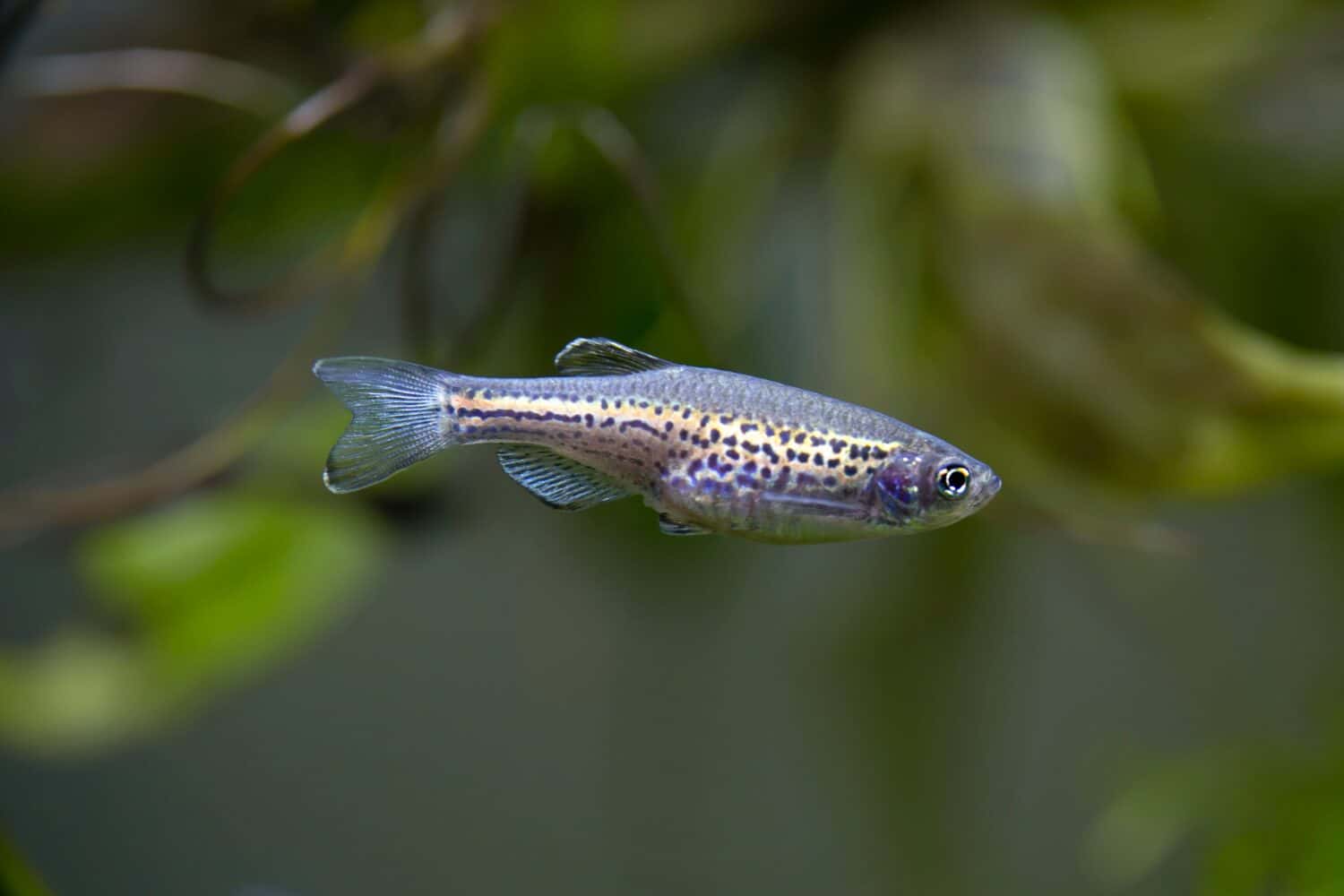
Leopard danios are a variant of the popular zebra danio, therefore they share a similar scientific name.
©boban_nz/Shutterstock.com
| Adult size: | 2 – 2.5 inches |
| Lifespan: | 3 – 7 years |
| Minimum tank size: | 16 gallons |
| Water temperature: | 65° – 80° Fahrenheit |
The leopard danio is a selectively bred variant of the zebra danio, scientifically known as D. rerio var. frankei. They are similar in many ways to the zebra danio and share the same care requirements. However, leopard danios have a spotted body rather than stripes. There are some theories that suggest that leopard danios came from the dwarf spotted danio, but genetic evidence has proven them to be a hybrid of D. rerio.
13. Red Finned Danio (Danio kyathit)

Danios can be found in various colors and patterns, such as the red-finned danio.
©Dan Olsen/Shutterstock.com
| Adult size: | 1.5 – 2 inches |
| Lifespan: | 3 – 7 years |
| Minimum tank size: | 16 gallons |
| Water temperature: | 70° – 80° Fahrenheit |
The peaceful and social red-finned, or orange danio is another striking species with an interesting appearance. Red-finned danios are found in Myanmar in the Irrawaddy River drainage system. They have deep red or orange fins as their name suggests, and a blue-striped body similar to the zebra danio. However, the red-finned danio has longer barbels framing their mouths.
They are not commonly kept in aquariums, but you might be lucky enough to find them available. Red-finned danios usually grow to around 1.5 to 2 inches long and can live up to five years with proper care. They need to be kept in spacious aquariums over 16 gallons in size and at a temperature above 70 degrees Fahrenheit.
Breeding Danios
Danios are egg-laying fish that reproduce by spawning via external fertilization. They are sexually mature at around three to four months old and can breed. The female danio will deposit eggs around the aquarium, usually over live plants, substrate, or driftwood. The male will fertilize the eggs with milt (sperm). The eggs usually hatch one to three days after fertilization.
Most danios will only breed in mature aquariums with well-maintained water. You can encourage them to spawn by doing frequent 10% to 20% water changes and feeding them a varied diet. Their aquarium needs to be cycled and filtered before you can start breeding them. This is because water quality is important. It is recommended to keep danios in groups of eight or more to ensure that there is a good female-to-male ratio for breeding.
Once the eggs have hatched, the fry is free-swimming and independent. They do not require any parental care, but some slight adjustments may be necessary for their environment. Danio fry prefers to hide amongst mossy plants like hornwort or java moss.
In Conclusion
It is clear why danios are such popular aquarium fish. Aside from an array of different species and therefore different colors and sizes, danios are highly social and peaceful fish. They do not have very demanding care requirements and are relatively easy to breed in the right conditions.
Summary of the 13 Types of Danios
| Number | Species of Danio Fish |
|---|---|
| 1 | Zebra danio |
| 2 | Pearl danio |
| 3 | Gold ring danio |
| 4 | Blue danio |
| 5 | Rose danio |
| 6 | Glowlight danio |
| 7 | Celestial danio |
| 8 | Black-barred danio |
| 9 | Giant danio |
| 10 | Moustached danio |
| 11 | Dwarf spotted danio |
| 12 | Leopard danio |
| 13 | Red finned danio |
The photo featured at the top of this post is © Andrej Jakubik/Shutterstock.com
Thank you for reading! Have some feedback for us? Contact the AZ Animals editorial team.







